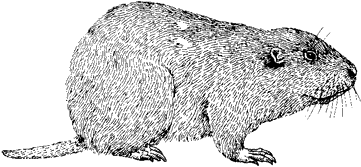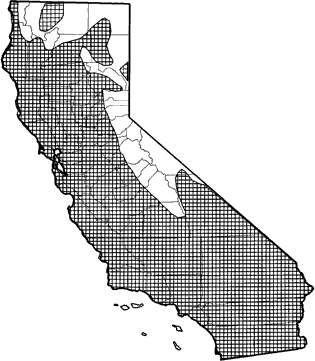
Botta's Pocket Gopher
Distribution, Abundance, and Seasonality
Abundant, yearlong resident the length of the state. Absent from elevations above 1520 m (5000 ft). Optimal habitats are perennial meadows, and grass and forb stages of most riparian-deciduous and conifer forests. Less common in mature stages of forest habitats.

Range Map
Specific Habitat Requirements
Feeding: Botta's pocket gophers are herbivorous. They feed mainly on roots, tubers, bulbs, stems, and leaves of forbs and grasses. Some shrub and tree seedlings are eaten, and occasionally young conifer plantations are damaged. Forage underground from tunnel , on ground surface, and from tunnels in snow. Chew roots from tunnels, and may pull entire plant into tunnel. Carry food in cheek pouches to underground caches.
Cover: Cover provided by burrows and tunnels. All entrances to tunnels are plugged with earth to keep intruders out, and to stabilize temperature and humidity (Ingles 1965).
Reproduction: Pocket gophers nest in burrows with deep chambers excavated in friable soils. Individuals usually remain in the same burrow system for life. Soil moisture and breeding activity are major factors affecting burrowing.
Water: Water needs probably met mostly from food plants.
Pattern: Pocket gophers require early stages of forest habitats, meadows, and grasslands with moist, friable soils.
Species Life History
Activity Patterns: Active yearlong. Mainly nocturnal above ground. May be active any time of day or night underground (Maser et al. 1981).
Seasonal Movements / Migration: Non-migratory.
Home Range: Territories and home ranges coincide. In California, home ranges of males averaged 251 m? (2700 ft?), and varied from 84-446 m? (900-4800 ft?). Those of females averaged 121 m? (1300 ft?), and varied from 23-242 m? (250-2600 ft?) (Howard and Childs 1959).
Territory: Both sexes are solitary and territorial. Territories break down only during breeding season (Howard and Childs 1959).
Reproduction: Mating and parturition may occur throughout the year in the southern portion of the range. Apparently there are peaks of breeding activity from February to April, July and August, and November to January. Gestation period about 18 days. Females produce 1-3 litters per yr, each of 1-12 young (average 4-5).
Niche: Botta's pocket gophers are solitary, fossorial mammals. Predators include owls, hawks, coyotes, foxes, skunks, badgers, bobcats, domestic dogs and cats, weasels, and snakes (Maser et al. 1981). Burrowing activities mix and build forest and meadow soils. Soil pushed into tunnels in snow settles in long, characteristic cores on surface during thaw. These help retard runoff. Pocket gophers are most numerous in disturbed areas where forbs and grasses are abundant (Barnes 1973). Sometimes a pest because of damage to crops, conifer seedlings, irrigation systems.
Sources & References
California Department of Fish and Game, 1999.
California's Wildlife, Sacramento, CA.
Written by: C. Polite, reviewed by: M. White, edited by: M. White
Barnes, V. G., Jr., 1973. Pocket gophers and reforestation in the Pacific Northwest: a problem analysis. USDI Bur. Sport Fish. Wildl. Spec. Sci. Rep. No. 155. 18pp. Capp, J. C. 1976. Increasing pocket gopher problems in reforestation. Vertebr. Pest Conf. Procs. 7:222-228. Howard, W. E., and H. E. Childs, Jr. 1959. Ecology of pocket gophers with emphasis on Thomomys bottae mewa. Hilgardia 29:277-358. Ingles, L. G. 1965. Mammals of the Pacific states. Stanford Univ. Press, Stanford, CA. 506pp. Maser, C., B. R. Mate, J. F. Franklin, and C. T. Dyrness. 1981. Natural history of Oregon coast mammals. Pac. Northwest For. And Range Exp. Sta., USDA, For. Serv., Gen. Tech. Rep., PNW-133. 496pp. Williams, S. L., and R. J. Baker. 1976. Vagility and local movements of pocket gophers (Geomyidae: Rodentia). Amer. Midl. Nat. 96:303-316.
California Animal Facts | California's Wildlife